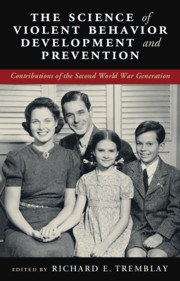 The Science of Violent Behavior Development and Prevention
The Science of Violent Behavior Development and Prevention Published online by Cambridge University Press: 28 January 2021
Friedrich Lösel was born in Germany in 1945. He is Emeritus Professor at Cambridge University (UK), as well as Erlangen University and Berlin Psychological University in Germany. He received the Stockholm Prize in Criminology, the Sellin-Glueck Award from the American Society of Criminology, and the Joan McCord Award from the Academy of Experimental Criminology. He created the Erlangen–Nuremberg Development and Prevention Study (ENDPS), which combined a prospective longitudinal and experimental design and investigated more than 600 children and their families from kindergarten to adolescence. The ENDPS showed that accumulated individual and social risk factors at preschool age predicted behavior problems in youth, but there was also developmental flexibility. The prevention part of the ENDPS implemented a universal training of child social skills, a parent training on positive parenting, and a combination of both. There were substantial short-term effects and promising outcomes after 10 years. The ENDPS team trained about 2,000 facilitators for a nationwide dissemination of the program. He also carried out an important longitudinal study on school bullying showing that intensive bullying perpetration was not only a school phenomenon but correlated with violence in other contexts and with criminal behavior in adulthood.
To save this book to your Kindle, first ensure no-reply@cambridge.org is added to your Approved Personal Document E-mail List under your Personal Document Settings on the Manage Your Content and Devices page of your Amazon account. Then enter the ‘name’ part of your Kindle email address below. Find out more about saving to your Kindle.
Note you can select to save to either the @free.kindle.com or @kindle.com variations. ‘@free.kindle.com’ emails are free but can only be saved to your device when it is connected to wi-fi. ‘@kindle.com’ emails can be delivered even when you are not connected to wi-fi, but note that service fees apply.
Find out more about the Kindle Personal Document Service.
To save content items to your account, please confirm that you agree to abide by our usage policies. If this is the first time you use this feature, you will be asked to authorise Cambridge Core to connect with your account. Find out more about saving content to Dropbox.
To save content items to your account, please confirm that you agree to abide by our usage policies. If this is the first time you use this feature, you will be asked to authorise Cambridge Core to connect with your account. Find out more about saving content to Google Drive.